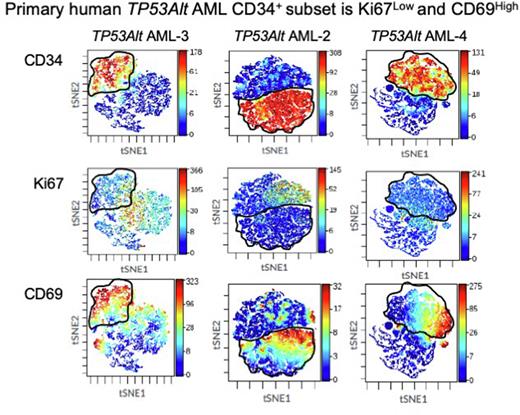Abstract
In acute myeloid leukemia (AML), standard therapies induce complete remission in 50-70% of patients, but the overall two-year survival is less than 20-30% because of high relapse rates. AML with mutations or deletions in TP53 (TP53 altered, TP53Alt) is a poor-risk AML subtype that is largely insensitive to chemotherapy, modern targeted agents, and hematopoietic stem cell transplantation. TP53Alts are seen in approximately 10-20% of AML and confer a particularly poor prognosis decreasing the 1-2-year survival rates to 0-10%. Leukemia stem cells (LSCs), the cells that recapitulate and propagate leukemia, are central drivers of leukemia progression and relapse. Therapeutically targeting LSCs is important to curing AML, but LSCs are poorly proliferative in contrast to bulk AML cells and are less sensitive to standard chemotherapy. Despite a broad literature defining the immunophenotype (the cell surface marker expression profile) and mechanisms of self-renewal of LSCs, the TP53 status has not been reported in most studies of human LSCs. Our goal is to define the immunophenotype and molecular states of primary human TP53Alt LSCs.
First, we asked whether the LSC immunophenotype of TP53Alt AML is consistent with that of the previously reported LSC immunophenotype in AML. We sorted primary human TP53Alt AML samples and plated cells from sorted compartments in serial colony forming assays (which serve as an in vitro surrogate for self-renewal). We found that the Lineage-CD34+CD38-compartment is enriched in serial colony forming capacity in four primary human TP53Alt samples tested. In another TP53Alt sample, we found that the Lineage-CD34+CD38any compartment was enriched for serial colony formation. In vivo engraftment studies recapitulated these findings in one of the TP53Alt AML sample we tested. In the two CD34-TP53Alt AML samples studied the lineage-CD123+ compartment was enriched in serial colony forming capacity. Together, these findings suggest that the standard AML LSC markers also identifies the LSC compartment of TP53Alt AML. Next, we used mass cytometry (CyTOF) to define the proliferative and signaling states of human TP53Alt AML samples. Previous work has demonstrated that the LSC compartment of AML is poorly proliferative, relative to the bulk leukemia population. Consistent with these findings, we found low levels of Ki67 (a proliferation marker) expression, in TP53Alt LSCs, relative to bulk leukemia cells, in every primary TP53Alt AML that we profiled (n=7). Notably, we found that TP53Alt LSCs express high levels of pNFkB, p4EBP1, and pSTAT5, suggesting that these signals may mediate self-renewal in TP53Alt AML. Indeed, we found that CD69, an NFkB target gene, is elevated in TP53Alt LSCs and minimally expressed in bulk leukemia cells. Furthermore, we found that Ki67 levels are low in the CD69High subset, suggesting that this is a poorly proliferative subset (consistent with having self-renewal capacity). Finally, we sorted primary samples according to CD69 status and found that CD69marks a subset with enhanced serial colony forming capacity. Together, these findings demonstrate that traditional LSC markers can be used to study TP53Alt LSCs and that NFkB activation is correlated with self-renewal function in these LSCs.
Disclosures
No relevant conflicts of interest to declare.
Author notes
Asterisk with author names denotes non-ASH members.


This feature is available to Subscribers Only
Sign In or Create an Account Close Modal